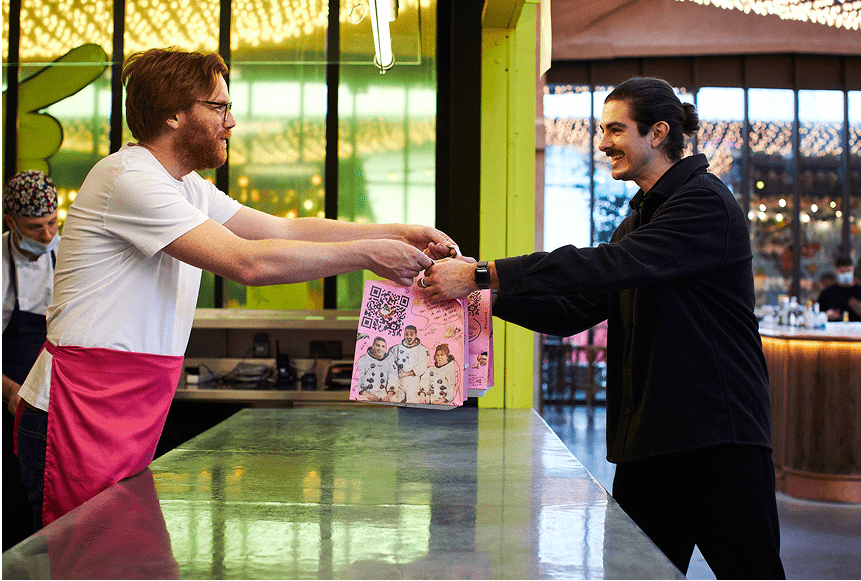
Why British Eateries Are Embracing Smart Terminals Over Traditional Card Machines
Welcome to the Future of Restaurant Payments
Picture this: it’s 2025, and a bustling London café has a queue that snakes around the corner. Hungry guests enter, order, and relax without the usual scramble to split bills or busy themselves waving a plastic card at an outdated terminal. Instead, a friendly member of the serving team—who may greet vous with a charming smile (if you’re in a French-influenced spot)—approaches the table with a sleek handheld device that does it all. Gone are the days when you had to wait for staff to “fetch the card machine.” Now, payment is sorted in seconds, complete with tip preferences and even a prompt to leave a review online.
While the devices themselves might be small, the conversation around them looms large. Should you stick with the tried-and-true legacy card machine, or upgrade to the new generation of “smart terminals”? How does it affect your costs, your staff, and most importantly, your guests?
In this article, we’ll dive into what restaurant owners are truly choosing in the UK and beyond. We’ll clarify what sets a smart terminal apart from a traditional card machine, examine the key factors your peers are prioritising, and highlight some forward-thinking payment features—like sunday’s QR code-based solution—that could elevate your dining experience for guests and staff alike.
Defining the Smart Terminal vs the Traditional Card Machine
Before we look at why many restaurants are shifting, let’s set the stage properly. There may be confusion about what these terms really mean, so let’s dig in with clarity and simplicity.
Traditional Card Machine
The “traditional card machine” (some might call it a “legacy card reader”) is what your customers have been used to for over two decades. A staff member hands them a separate handheld terminal. The diner inserts or taps their credit or debit card, adds a tip if they wish, waits for authorisation, and takes a paper receipt. While these terminals have gradually added contactless and EMV functions, they remain fairly limited in scope. Most can’t run new apps, integrate advanced analytics, or seamlessly update software the way a more modern device can.
Smart Terminal
Meanwhile, a “smart terminal” is like a sophisticated smartphone in payment form. Think of it as a multi-tasking tool that doesn’t just process payments but also integrates with your stock management, your staff scheduling, your new payment solution (for instance, if you want to implement a QR code at the table), and so much more. With additional capabilities—like direct tipping prompts on screen, loyalty programme sign-ups, or immediate digital receipts—staff and guests can move through the payment process quickly yet more interactively. Many are also designed to receive frequent software updates without any clunky reconfiguration, ensuring you’re always kept in the loop as technology evolves.
The Shifting Payment Landscape in the UK
The UK has long been at the forefront of payment innovations, particularly with the rise of contactless. According to UK Finance, contactless now accounts for a substantial share of in-store transactions, indicating a strong consumer appetite for convenience and speed. As usage has soared, so has the tolerance for new ways to pay—making it the perfect environment for advanced solutions like smart terminals.
By 2025, experts project that digital tipping and frictionless payments (like scanning a QR code on the table or splitting the bill from a person’s phone) will become even more widespread. For restaurant owners evaluating new hardware, the question is clear: if you’re going to invest in a new payment device, do you really want something that’s “just a card machine”?
Why Smart Terminals Matter to Restaurant Owners
If you’re running a gastropub in Liverpool or a fine-dining spot in Chelsea, your primary concerns could be the same: keeping costs under control, keeping the flow of service high-quality, and avoiding anything that upsets the daily operations. So, why are smart terminals increasingly becoming the choice for many restaurant owners?
- Integrated Systems: A smart terminal can connect directly to your point-of-sale (POS) software, your reservation manager, and even your staff’s scheduling apps, cutting down on the countless devices you used to juggle.
- Faster Payments: Contactless cards, Apple Pay, Google Pay, and other digital wallets are processed swiftly. Fewer lines form at the till, allowing staff to handle more tables efficiently.
- Real-Time Data: Smart terminals often come equipped with analytic dashboards that let you see sales patterns, busiest hours, staff tip performance, and more. That data can feed directly into better decision-making.
- Customisation: Add a splash screen with your restaurant logo, highlight new menu items, or prompt guests to leave a review online—right from the device’s interface.
- Customer Experience: With a streamlined checkout, your guests no longer have to wait for a separate device or sign unclear receipts. The entire process feels smooth, personal, and even enjoyable.
- Easy Software Upgrades: No need to wait for a new physical device each time there’s a compliance or feature update. Most smart terminals deliver over-the-air updates that keep you on the cutting edge.
- Security: Smart terminals are built on modern, secure frameworks that can handle PCI compliance and encryption seamlessly.
How Traditional Machines Compare in 2025
We can’t downplay the reliability of a solid, old-school card machine. Many restaurants still keep at least one on hand as a backup, and they remain a somewhat cost-effective fallback. Nevertheless, these older devices have their limitations.
- Narrow Functionality: Traditional machines are built predominantly to take card payments, process tips, and print a receipt. Extra features—if available at all—are usually minimal or require expensive modular add-ons.
- Outdated Interfaces: Staff might struggle with slower interactions, tiny screens, or dated keypads—none of which are particularly inviting or engaging for customers experiencing modern retail environments elsewhere.
- Lack of Direct Integrations: Because they’re not built on an open software platform, hooking a traditional machine into your restaurant’s reservation system or loyalty programme often isn’t straightforward.
- Rare Software Updates: These devices don’t typically receive real-time improvements or new features. Once you purchase them, what you see is largely what you get.
Cost Implications: Investment vs Payoff
At a glance, it may seem cheaper to keep using a legacy card machine. You bought it years ago, and it still works—so why upgrade? The answer comes down to real costs versus superficial savings. If you’re continuing with a standard device that costs you less on paper, are you missing out on the bigger picture?
Here’s a comparison table that encapsulates some typical cost considerations for a smart terminal versus a traditional machine:
| Smart Terminal | Traditional Card Machine | |
|---|---|---|
| Initial Hardware Cost | Moderate to High | Low to Moderate |
| Maintenance & Upgrades | Regular software updates often included | Hardware replacement or limited firmware updates |
| Transaction/Processor Fees | Competitive, but vary by provider | Often fixed or standard rates |
| Integration with POS/Mobile Apps | Seamless (often included) | Rare or requires third-party solutions |
| Functionality | Multi-purpose (sales analytics, loyalty, etc.) | Limited to payment processing |
While the upfront investment for a smart terminal can be higher, many owners find that integration, improved efficiency, and richer customer experience offset these costs in months rather than years. For instance, if your staff can turn tables faster because the payment flow happens more quickly, you might see incremental gains in daily revenue. Additionally, loyalty sign-ups and better tip prompts can help keep both customers and employees happier.
The Allure of QR Code Payments and More
If you’re weighing whether to go smart or stick to tradition, consider modern features that drive a restaurant’s bottom line in 2025. QR code payments have been a breakout star in the last few years—letting diners scan a code on the table using their phone to bring up a checkout page, add tips, and pay instantly.
In parallel, solutions like sunday provide a contactless, at-table way for guests to pay without requiring them to install any new app. This means faster turnover, no waiting around for a staff member to bring the device, and the option to leave a Google review right on the spot. The next wave of UK restaurant tech revolves around making earlier friction points—like splitting the bill—effortless and even fun. Smart terminals can integrate these features directly, bridging the gap between traditional card usage and phone-based experiences.
While a legacy card machine might allow for contactless taps, you’ll rarely see it provide a frictionless link to an online store, a delivery partner, or a digital tip jar. For that, you’d likely need a separate device, an additional aggregator, or just skip it altogether. Smart terminals excel at combining these elements into one streamlined package.
Emphasising Staff and Guest Satisfaction
In many ways, restaurant life is about people, not just technology. Good equipment is only beneficial if it serves the staff’s needs—making them more efficient, lowering stress, and giving customers the sense that they’re truly welcome.
Here’s why many staff members prefer a modern smart terminal:
- User-Friendly Design: A large touch screen with intuitive menus can massively reduce training time and errors at the till.
- On-the-Spot Menu Updates: Running out of a special? You can remove it from the available items in seconds, so staff don’t accidentally charge for something that’s not in stock.
- Stress-Free End-of-Day Reconciliation: With real-time data sync, staff can automatically see tips, sales, and refunds, making it easier to reconcile at closing.
- Better Guest Engagement: Instead of focusing on fiddly payment processes, servers can focus on warm interactions—ensuring customers feel welcomed and informed.
Diners also benefit from the speed, convenience, and clear tipping prompts. Most guests don’t want to be stuck waiting for five minutes after their meal just to handle payment. When the experience is streamlined, they’re more likely to leave with a positive impression—and possibly a review praising your efficiency.
Is Security an Issue?
Smart terminals are built with security in mind—often more so than many older card machines that might be reliant on outmoded encrypted connections or slower compliance updates. Payment hardware providers in the UK must comply with guidelines to ensure protection of sensitive cardholder data, whether you’re using a legacy device or something new. However, the agility of a software-driven device means it can often adapt faster to emerging threats by automatically deploying patches. That’s a huge advantage in a world where data breaches can severely damage a restaurant’s reputation.
The Trend: Real Stories from the Industry
Take the example of a family-run Italian restaurant in Manchester that decided to roll out six smart terminals across its two dining rooms. Their primary motivation? They wanted to reduce the chaos around the end of a meal. Before, they had just one old card machine roaming the space. This led to bottlenecks, especially during peak weekend hours. Sometimes, staff even lost track of where the device was, or the battery would run out, forcing them to dash to the charging station in the middle of rush hour.
Now, each section has its own smart terminal. Staff can access updated menu items, highlight daily specials, and process all forms of digital payments. Guests can seamlessly add a tip and get an e-receipt, which has significantly cut down on paper costs. Within six months, the restaurant reported a 20% reduction in average table turnover time and a 12% increase in total monthly tips collectively. Source data from the restaurant’s own analytics, integrated with the device, confirms these improvements were directly connected to the new payment solution.
While this scenario focuses on a single business, it’s representative of a broader trend: restaurants in the UK discovering that the transition to a smart terminal yields measurable benefits to both the bottom line and the overall vibe of their dining experience.
Support and Scalability
Another plus: top-tier smart terminals and payment solutions generally come with immediate support and cloud-based updates. When you’ve got a queue out the door, the last thing you want is a meltdown that leaves you fumbling for the old mechanical card imprinter (if you even remember those!). Smart devices can often be troubleshot in real-time, even remotely drawing on advanced diagnostics. If you’re a multi-location operator, having that consolidated view of all your restaurants’ transactions becomes an invaluable resource for forecasting and planning.
Scalability is easier too. If you open a new branch, you can replicate the installation with minimal fuss. The same digital environment—payment interface, digital menu, integrated QR code solution—can be deployed at the new location, giving you consistent branding and processes across your entire group.
Should You Ditch Your Traditional Machine Entirely?
Here’s where the nuance comes in. Some businesses choose to keep one traditional card machine as a fallback, mostly for peace of mind or in case they need a second form of payment acceptance. However, in 2025, the majority of restaurants adopting a new payment system are unlikely to invest in a purely traditional device if they haven’t already owned one for years.
Hybrid approaches might make sense for smaller establishments that want both: a full-featured smart terminal for daily usage, plus an older backup for emergencies. In time, though, as the technology becomes increasingly affordable, visual, and user-friendly, you might see fewer and fewer owners bother holding onto old equipment that can’t keep up with modern expectations.
Stepping into 2025 with Confidence
As a restaurant owner operating in the heart of a competitive UK market, you face a daily balancing act between tradition and innovation. Of course, the food, atmosphere, and the personal touches you bring to your trade are crucial—but ensuring each stage of the dining journey is smooth, from ordering to paying, is equally vital. By 2025, consumer expectations are only set to rise, with rapid service, digital convenience, and integrated experiences at the forefront.
A final factor: payments are one of the last interactions guests have with your restaurant, so it’s crucial that it leaves a positive final note. Whether you incorporate QR codes on every table or rely on a sleek handheld smart terminal, the immediate advantage is in enhanced speed and convenience. Long term, the data, integration possibilities, and improved staff experience all potentially mean higher revenue and stronger guest retention.
A Quick Recap on Key Benefits
We’ve covered a lot of ground, so let’s quickly spotlight the main advantages of the smart terminal approach in 2025:
- One-Stop Integration: Fewer gadgets to juggle, smoother staff operations.
- Future-Ready Software Updates: Stay up-to-date with payment tech trends without overhauling your hardware.
- Improved Guest Satisfaction: Faster transactions, easily adjustable tips, digital receipts, potential for contactless or phone-based payments.
- Greater Staff Productivity: Reduced errors, fewer bottlenecks, simpler end-of-day reconciliation.
- Data and Analytics: Access to real-time sales dashboards can help shape menu decisions and operational strategies.
- Enhanced Security: Proactive compliance, swift patches, and robust encryption standards.
FAQ: Common Questions from Restaurant Owners
How do I know if my restaurant is ready for a smart terminal?
Assess your current payment flow. Are you experiencing queues or confusion around bill splitting? Are you looking to integrate data from payments into your larger operations? If you want to offer modern conveniences like contactless tipping or QR code payments, a smart terminal might be the logical next step.
What about ongoing costs compared to a traditional card machine?
While smart terminals can be pricier upfront, the better integration, reduced errors, and upsell opportunities often lower your total costs over time. You may also gain better insights into your sales and operations, potentially saving money in the long run and increasing revenue.
Which payment methods are compatible with a smart terminal?
Most smart terminals can accept a wide range of payments, including all major credit cards, debit cards, contactless cards, mobile wallets like Apple Pay and Google Pay, plus QR code-based solutions such as sunday. This versatility is vital in meeting modern customer preferences.
Is the switch complicated for staff and guests?
Smart terminals often come with user-friendly interfaces. Staff typically adapt quickly when the screen guides them through steps like splitting bills or applying discounts. Guests also find it straightforward—especially when they can simply tap or scan, leave a tip, and confirm the payment in seconds.
Could a smart terminal help me gather more positive reviews?
Yes, many smart terminals (or their integrated solutions) allow you to prompt customers to leave feedback or a Google review right after paying. By making it quick and convenient, you’re more likely to capture those responses while the dining experience is fresh in their minds.
In 2025, as consumer expectations and technology continue to merge in exciting new ways, the choice for most restaurants is clear. A forward-focused payment solution—like a smart terminal or a seamless QR code payment experience—can elevate your brand, delight your diners, and support your staff all at once. Whether you’re a Michelin-star eatery or a community café, embracing these modern payment methods now could make the difference between keeping pace and truly setting the pace in the ever-competitive restaurant scene.
Find out more today
Drop us your details below and we’ll reach out within the next 24
The payment terminal to make your operation simpler.
Connected to your POS, we offer the only payment terminal specifically designed for restaurants.




